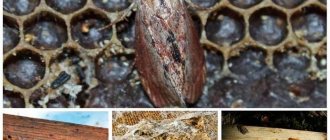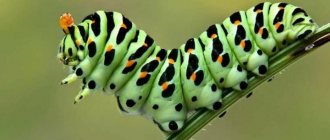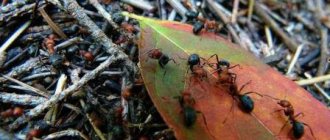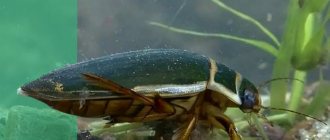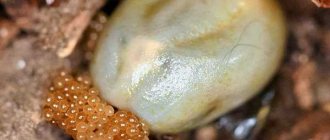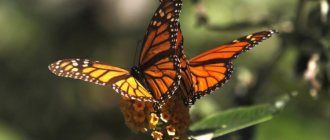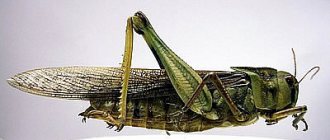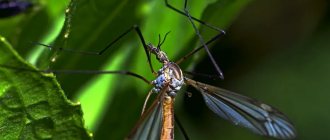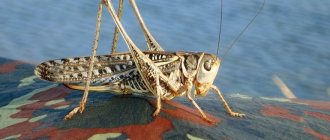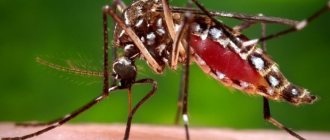The first stage of bee development is its larva. Brood emerges from fertilized or unfertilized eggs on the 4th day after laying. The larvae grow very quickly and eventually develop into fertile queens, male drones or worker bees.
The brood absorbs a large amount of royal jelly, as a result of which many useful substances (fats, proteins, minerals, carbohydrates) accumulate in its body. That is why it is used not only for growing adults, but also for medical purposes.
The structure of a bee larva
The structure of a bee larva is simple. Its distinctive features:
- small head;
- color – white or light yellow;
- body shape – worm-shaped;
- the body consists of several segments - thoracic and abdominal;
- the outer shell has a chitinous shell.
The larva has the same internal organs as the adult, but not fully developed.
Bee larvae have a very small head - it consists almost entirely of jaws. The larvae eat a lot, thoroughly chewing food - animal and plant.
Internal organs:
- The intestine is the most important internal organ of the larvae. Its structure:
- The foregut is a short tube with developed muscles. Thanks to intestinal contractions, the larva absorbs liquid food.
- The midgut occupies the main part of the body. Excretory organs stretch along it - four Malpighian vessels.
- The hindgut has a curved shape. At the end is the anus.
While the larva eats and grows, it does not excrete feces - the bees do not have to clean it up. At first, food debris does not enter the anus, since the hindgut does not communicate with the midgut. They connect later.
Rest of the structure:
- Heart. Has 12 cameras. Located in the back area. Adult insects have only 5 chambers.
- Respiratory system. These are tracheal trunks with many branches - located throughout the body.
- Fat layer . Makes up to 65% of the total mass. Plastic substances accumulate in the fat layer.
- Nervous system . There are two nodes of elementary structure - suprapharyngeal and subpharyngeal.
- Genital organs . They are underdeveloped and in their infancy. Throughout the life of the larvae, the ovary rudiments grow. Drone larvae have the rudiments of testes.
- Organ rudiments . The larvae have a resemblance to the legs, wings and other organs of an adult insect, which are formed at the embryonic stage.
The larva has no eyes or sense of smell. Thanks to the spinning glands located on the lower lip, future bees spin cocoons.
Cold Brood
This disease develops at low temperatures in the nest. It is not contagious, but the larvae still die. It is more often observed among offspring at the open stage.
Note the dark cells. These larvae have already died. The disease appears in early spring, when the bees' wintering is over, but at night the temperature is still low
If the hives are not insulated, then the frozen brood, which is located near the walls of the hive, is affected
The disease appears in early spring, when the bees' wintering is over, but the temperature at night is still low. If the hives are not insulated, then the frozen brood, which is located near the walls of the hive, is affected.
The disease can be distinguished by the changed color of the larvae, which first acquire a gray tint, then become black. Then they dry out and crumble.
Prevention measures
To avoid disease, it is necessary to control the temperature in the hive and properly insulate it.
If the first signs of the disease are noticed, the affected offspring are removed and the nest is reduced so that the distance between the frames is no more than 1 cm. Then you need to eliminate the cause - stabilize the temperature in the hive.
Stages of development
Bees are insects undergoing complete metamorphosis. Before the worms, which will become bees in the future, begin spinning, their skin will have time to change four times! Each stage of development of an individual is characterized by a certain body structure, feeding habits and behavior. The entire period of larval development is divided into 4 stages:
- eggs;
- larvae;
- pupae;
- adults.
Active growth
Each adult bee grows from an egg laid by the queen. The breeder attaches the eggs to the bottoms of the honeycomb. After a day, the eggs tilt, and after three, they take a horizontal position, laying on the bottom of the cell. The egg develops into a small white larva.
First, the larva receives milk from the queen - she deposits it directly into the cell. She is fed milk for three days. On the fourth day, the young animals are fed beebread and honey. The first stage of development lasts three days and is completely identical for all categories of the bee genus - queens, worker bees and drones.
Queens are produced from fertile eggs, drones from infertile ones.
Active development is observed within six days. This stage is characterized by rapid growth. Weight from 0.1 mg increases to 150 mg. A moment comes when the corroded creature becomes cramped - it stretches along the cell, moving its head towards the exit. By this time, feeding ends. At the first stage, the formation of the rudiments of legs and antennae and all internal organs occurs.
To raise 10 thousand larvae, 0.5 kg of pollen and 1 kg of honey are consumed. To feed one embryo, a whole cell of beebread is needed.
After 6 days, the queen seals the cells with the young. A special composition of wax and pollen is used for sealing. The uterus leaves a hole for air to enter. While in the sealed honeycomb, the larvae begin to create cocoons around themselves, turning into pre-pupae.
Prepupa
Once in the sealed cell, the larva straightens up and spins a cocoon - pupates. This is the pre-pupal stage. A prepupa develops inside the spun cocoon. A day later the process ends. A few hours later - molting. It's time to change your skin once again. The old casing is sent to the end of the cell, where it is mixed with feces.
Doll
This stage can be called the adult bee stage. The skeleton of the pupa hardens and becomes dark. After a few days, young individuals appear. As soon as the last, fourth skin change occurs, the bees begin to gnaw on the lid covering the cell. As soon as the path is clear, the young insect escapes to freedom.
When an individual gets out of the cell, it leaves its cocoon in it. Because each cell lasts for many generations over the years, the white honeycomb eventually turns yellow, then light brown, then completely dark. The bottom and walls become thicker, so old combs look narrower and shorter - weak individuals develop in them, with small wings and a short proboscis.
Young animals, unlike older individuals, have a chitinous skeleton and a soft body covered with fine hairs. Over time, the shell hardens, the hairs rub against the walls, and the bee’s body becomes shiny and hairless. The development of a worker bee lasts approximately 21 days.
How do bees develop in a hollow?
The process of brood development in wild and domestic bees is not much different. Insects go through similar stages of development. The only exception is that beekeepers can provide their bee colonies with the necessary microclimate for the development of larvae, while wild bees do everything on their own.
In addition, it is important to take into account the fact that domestic bees use the same cells to raise offspring a large number of times. Until they are replaced by a beekeeper. Since during the life of the larvae, the cells become smaller and weak individuals are born. Wild bees fill brood cells with honey, as such combs become much stronger over time, as a result of which they do not collapse.
Shedding
The larva grows, and its skin retains its original size. We have to shed the old skin so that the plump body gets a new, more comfortable “shirt”. Let us repeat - the larva moults four times before sealing the honeycomb.
Before molting begins, feeding stops. The shell, losing its shine, becomes dull. The old skin, bursting in the head area, tears along the back. A larva with a new skin crawls out of the resulting hole. The skin changing process lasts 1 hour 20 minutes.
Immediately after molting, the individual remains motionless and absorbs a minimum of food. The discarded shell is not thrown away - it remains in the honeycomb. 6 days after hatching from the egg, the larva receives the last portion of food, it is sealed in a honeycomb - it begins to spin a cocoon. The individual completes the task within 24 hours. Next, the future bee is overtaken by the fifth molt - this occurs 4 hours after the completion of spinning the cocoon. A creature born after the 5th molt is no longer a larva. He has all the signs of an adult bee.
The pupa is a preliminary stage, separated from the adult by another stage - the final molt. As soon as the last change of skin is completed, the insect comes out, gnawing the lid of the honeycomb.
How much does a bee colony cost?
Bee packages are the minimum bee colony.
A strong bee colony is considered to be a hive of 30 to 45 thousand bees of different levels. The total weight of the bee colony is about 8-13 kilograms of bees, which can fit on 36 frames. A novice beekeeper cannot cope with so many bees at once. For ease of sale, there is such a thing as a bee package.
The minimum bee package includes:
- 1.2 kilograms of bees;
- 1.5 brood frames;
- Some food from the hive;
- Several hundred.
The bees in the bee package are a full-fledged bee colony with a queen.
Bee packages can be:
- Frame or cellular;
- Frameless (honeycombless).
The cost of a bee colony depends on the cost of packaging, which is about 10-15% of the bee package depending on the bee breed. Frame bee packages include from 4 to 8 frames (prefabricated or branched). The prefabricated frame is formed from brood of different ages from different families. A non-assembled frame is obtained by dividing a large bee colony into several layers. The fetal uterus is placed in the formed frames. The number of insects in one bee colony depends on the wishes of the buyer.
Frameless bee packages are a bee club with a queen and no brood. You can purchase bee packages of Carpathian bees in a corrugated container of four frames with brood and a feeding frame for 4,500 rubles. Buying a bee colony with a hive will cost a little more, since a full-fledged bee colony has about 12 frames, which will be three bee packages. Buying a bee colony will cost about 6,000 rubles, which is clearly more profitable than buying a bee package.
The initial purchase of bees, as a rule, is carried out by the bee colony, and subsequent replenishment of the apiary can be carried out in bee packages.
The Carpathian breed of bees is resistant to various diseases and low temperatures, and also produces more honey.
Care
In order for a bee colony to live and develop safely, it needs a certain microclimate. Bees are sensitive to any changes in conditions - temperature, humidity, carbon dioxide concentration. The optimal temperature in the brood zone is +35°C, humidity is 80-85%. If the temperature drops, the bees become passive - they save energy reserves.
Carbon dioxide content
The concentration of oxygen and carbon dioxide in the hive depends on the characteristics of a particular bee colony - its strength and development. Bees respond to changes in carbon dioxide levels with thermal receptors. Its concentration varies from the periphery to the center and depending on the season.
When transporting bees by road, the carbon dioxide content in the hives reaches 4%. Insects get stressed and tend to move into the space above the frames - this worsens gas exchange. If ventilation is insufficient, the bees may die without surviving transport.
As the season comes to an end, the gas concentration increases from the periphery to the center. At the beginning of autumn and spring, the concentration of carbon dioxide in the center is 1.1%, in the periphery - 0.6%. When cold weather arrives, the values change to 3 and 1%, respectively.
Nutrition
Feed is supplied 2-4 times more than the volume of the egg. If there is not enough food, the larva will die from malnutrition. After contact with bee jelly, the egg cracks, revealing the body of the larva. If there is no food, the egg will dry out without cracking - death occurs.
During the first days, the young animals are fed with milk produced by young bees. Further feeding depends on the hierarchy:
- future uterus - diet does not change;
- worker bees and drones receive honey and bee bread.
Rapid weight gain occurs. After 5 days the larvae weigh:
- queen bees – 340 mg;
- drones – 360 mg;
- worker bees – 130-150 mg.
The future queen will receive food 1600 times, worker bees - 140-150 times.
Temperature
At the first stage of development, the larva is extremely vulnerable - it needs a certain ambient temperature. If the temperature is below normal for at least 15 minutes - during the first 8-14 hours of development, an individual will develop from the egg, combining the characteristics of a bee and a drone.
If the temperature deviates for a long time in any direction, the insects will die.
Temperature affects the development time of queen bee larvae, drones and worker bees. The optimal temperature is +32…+35°C. If the temperature drops to +30°C, the duration of development will increase; if it rises to +38°C, it will shorten.
Humidity
It is important to organize good air exchange in the hive. For this purpose, the hives have upper entrances and ventilation slots. If ventilation is insufficient, condensation appears, due to which mold may appear on the walls of the hive, and the wood acquires a maximum humidity of 30%.
For the entire life span, a bee colony needs 30 liters of water. Water carriers make up to 100 flights daily, each time bringing 30-50 mg to the nest.
Honey can affect the humidity of the nest, and it not only moisturizes, but also dries out the space inside the hive. What you need to know about humidity:
- If air humidity reaches 60-65%, and honey contains 17-18% water, then moisture is not released or absorbed.
- If the humidity rises to 70%, honey absorbs water vapor - it contains up to 30% water.
In winter, bees consume food with a water content of 30%. Winter stocks do not have as much moisture. Therefore, the moisture content of the feed is increased either by the bees themselves or due to the humidity of the hive. When insect activity decreases, regardless of the time of year, the concentration of carbon dioxide in the hive increases. Before cold weather - in the pre-winter period, the oxygen content decreases and humidity increases.
Medicinal properties
Worms have amazing healing properties:
- increased sexual desire;
- reduction of harmful cholesterol in the blood;
- blood pressure regulation;
- restoration of strength and energy;
- increased performance;
- prevention of prostatitis, as well as adenoma;
- improve blood circulation and circulation.
How does the development of worker bee, queen and drone larvae differ?
The formation of larvae lasts:
- queens - 16 days;
- worker bee – 21 days;
- drone – 24 days.
Worker bees are the basis of a bee swarm. They are the ones who feed the entire family - from birth to procreation. They also:
- build housing for the bee colony;
- perform the functions of security guards;
- prepare food and prepare it;
- tidy up the honeycombs and much more.
Moreover, the toiler is significantly smaller than the drone and the queen. They do not mate with drones because they do not have full-fledged reproductive organs.
The lifespan of drones is 2.5 months.
Male drones are needed to fertilize the queen. After communicating with the female, the drone dies, as it loses part of its reproductive organ. Born in the spring, males live until autumn - while they have the ability to reproduce. Drones mature 10-14 days after leaving the cell.
| Stages of development | Development timeframe | ||
| bee | uterus | drone | |
| egg | 3 | 3 | 3 |
| larva | 6 | 5 | 7 |
| prepupa | 3 | 2 | 4 |
| doll | 9 | 6 | 10 |
| duration of development | 21 | 16 | 24 |
The development of drones and worker bees is practically no different, except for the duration of development. The larvae of the queen, bee and drone go through the same stages - egg, larva, pupa, prepupa. The larvae of the first two emerge from fertilized eggs, while the drones emerge from unfertilized eggs.
Contraindications and possible harm
There are practically no contraindications to consuming larvae in their pure form. They do not have any side effects and do not harm the human body. However, before starting use, you should check the tolerance of the product. To a greater extent this applies to:
- pregnant and lactating women;
- young children;
- persons suffering from diabetes;
- allergy sufferers.
If larvae are used in the form of a tincture or paste, you need to pay attention to additional ingredients: honey, alcohol, etc. Do not forget that honey is a strong allergen, and alcohol is contraindicated for children and some categories of adults.
What is a homogenate?
Homogenate is the contents of the cell, including the larva itself and bee products. There are types of homogenate:
- Drone jelly is the milk of squeezed drone larvae.
- Royal is the most valuable product. It has a high content of royal jelly.
- Worker bees - there are actually only larvae in it. This product is in little demand.
Drone homogenate is obtained from cells with 6-7 day old larvae. They are taken out of the honeycomb and then ground into a homogeneous mass. The product rapidly loses its properties when exposed to sunlight. It is stored at a temperature of -5°C to -8°C. Shelf life – 1 month. It has a wide range of effects - from increasing immunity to increasing libido.
Royal homogenate is obtained from three-day-old queen bee larvae. The unique product actually consists of stem cells. It is an accumulator of bioactive substances and helps the regeneration of the aging body.
Drone and uterine homogenate contain the same vitamins. The first contains more decenoic acids, the second - proteins. They contain natural hormones - testosterone, estradiol, progesterone. There are no hormones in bee homogenate, but it does contain decenoic acids.
Recipes
Products prepared from larvae are not recommended for use during pregnancy or for young children. Such recipes should be used with caution if you are allergic to honey products, have poor clotting ability, or have thrombosis. It is better to consult your doctor first.
Milk is prepared from the brood - a homogenate. To prepare it, the larvae are crushed until smooth, placed in a container and put in the refrigerator. You can add honey in a ratio of 1:100. This will extend the shelf life. The product is consumed 1 tbsp. three times a day. Honey in this recipe can be replaced with a mixture of glucose and lactose. In this case, part of the larvae accounts for 12 parts of the mixture.
The brood is eaten raw and eaten. Some cooks fry or stew the larvae and serve them with vegetables or sauce. Larvae in berry marinade are delicious.
Artificial hatching of queen bees
There are several cases when you have to raise a new queen bee:
- To replace an aged queen bee.
- To form a breeding family.
- If the current queen bee dies.
- To obtain large volumes of hemogenate and royal jelly.
The problem solves itself only in the third case - if there is brood in the frame. The larvae should be transferred to queen cells and fed with milk. In all other cases, human intervention is necessary.
A beekeeper talks about breeding queen bees. A beekeeping specialist tells and shows how to place honeycombs to obtain one-day-old larvae:
There are two ways to remove queens artificially:
- A frame with eggs and brood is taken from a large and strong bee colony. A 3x4 cm hole is cut out on top. The lower walls of the cut are removed. Two larvae are left behind. Rama is placed in a hive with a queenless family. The method allows you to obtain high-quality material.
- This method is used if you need to remove several queens at once. The queen is placed in a good family, isolated between two frames. After 4 days, she is transferred to a nuc (special hive) with honey, bees and dry food. The frame with brood obtained in 4 days must be returned to the “native” hive. We need to work on it - cut off the cells without larvae.
Find more information about breeding queens here.
Bee larvae, being potential adults, can not only replenish the bee colony with a queen, drones or worker bees, but also provide a valuable product used in medicine.
0
0
Copy link
Required temperature
Development cycle and their duration:
In order for the apiary to generate income, every little detail must be taken into account, and the correct growth and replenishment of the family is important. Therefore, it is necessary to create optimal conditions so that the development of insects and larvae proceeds correctly.
As a rule, the first sowing of brood is carried out at the beginning of the year, in February. The bees in the nest independently maintain the temperature, as well as the level of humidity in the environment where the worker bee develops. In order for the process to proceed correctly, the temperature must be within 32-35 degrees. If the indicator drops by even a degree, the brood will weaken, which often leads to developmental disorders. Various deformities may appear in the body or wings.
Exceeding the permissible temperature range leads to negative consequences, including the death of the larvae. When it gets especially cold outside, inside the hive, to protect the brood, insects create a wall on the cells that protects the future generation from changes in heat and cold. The bees press tightly together, resulting in their own microclimate to preserve each egg and larva.
A small gap present in the tap hole is used as ventilation. When the temperature begins to rise dangerously, the developing larvae are cooled by the wings of the adults. They swing frequently and quickly, creating wind that reduces heat.

